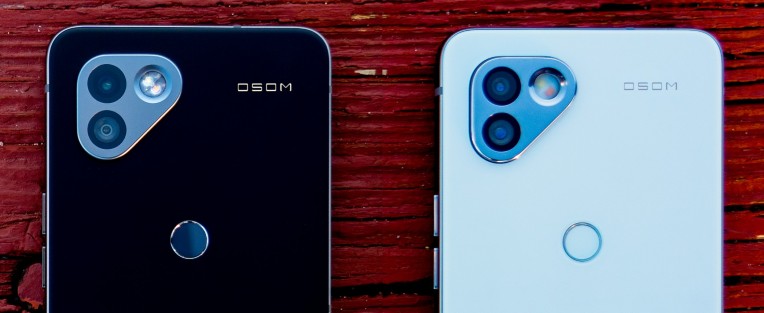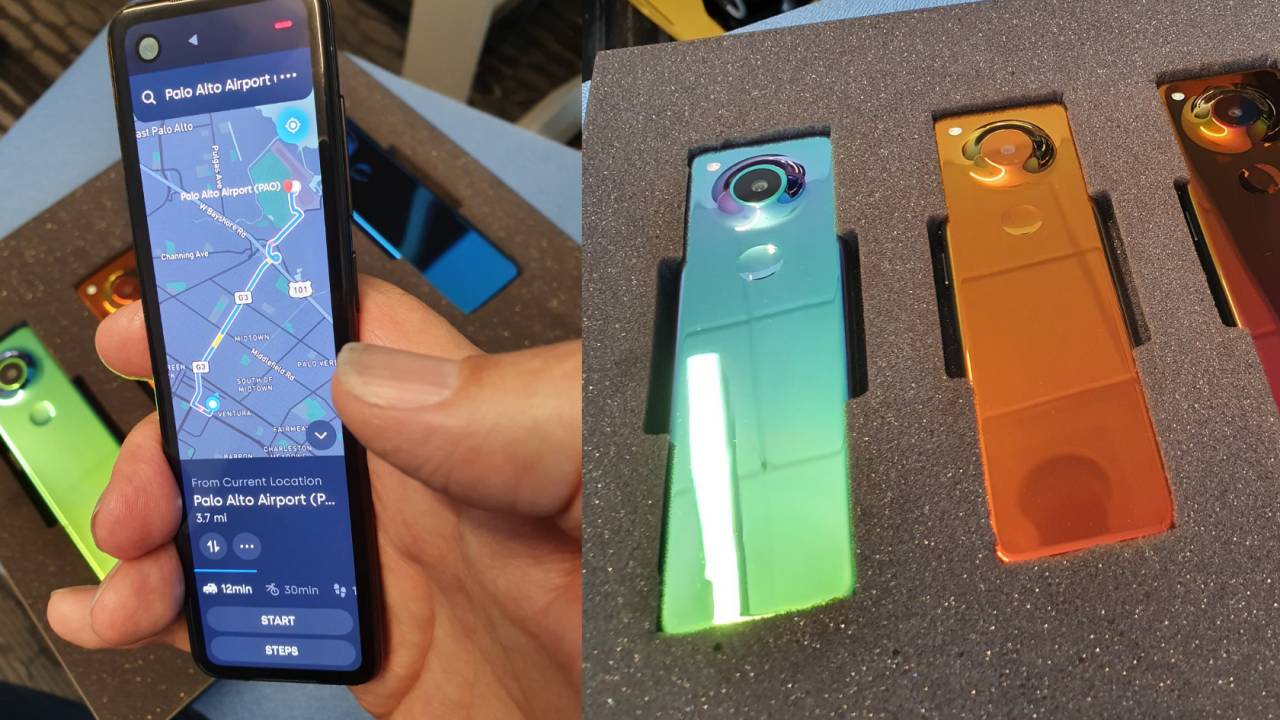After Essential’s failure, OSOM plans a new privacy-first handset

After Essential’s failure, OSOM plans a new privacy-first handset
Last year’s Essential implosion marked one of the most high-profile consumer electronics startup failures in recent memory. Launched in 2017 with $330 million, a killer pedigree and some truly grand ambitions, the company sputtered through a combination of industry issues, disappointment and troubling allegations against founder Andy Rubin.
The firm’s IP was eventually purchased by Carl Pei for his new company. But the executive eventually bucked the name in favor of “Nothing.” “[B]efore we were called Nothing, ‘Essential’ was one of the names we were brainstorming, internally,” he told me earlier this year “So that’s why we’ve acquired the trademark. We don’t have any plans to do anything with Essential.”
Something far closer to a spiritual successor arrives in the form of OSOM. The company, founded by ex-Essential employees, has had a smattering of press coverage over the past several months, but has largely kept quiet. Today, however, the Cupertino, California-based firm confirmed what many long suspected: OSOM (pronounced “awesome”) is working on a phone.
Its planned OV1 device is, at least aesthetically, very clearly the work of the same team that gave the world the Essential PH1. But rather than features like modularity, the product is designed with one core thing in mind: Privacy. Specifically, it’s designed to give users greater control over data privacy.
Beyond that, details are scarce, ahead of its planned MWC 2022 launch. We sat down with co-founder and CEO Jason Keats for more information on OSOM and its upcoming handset.

TC: We’re about two months out from the announcement?
JK: Yeah, we’re a couple of months out from sharing the fine details. We’re planning the give the full announcement at MWC, and then shipping summer 2022. Right now we’re ready to announce that we are building a phone. People are really excited. We wanted to give our fans something this year, and we’re coming in under the wire.
What constitutes a fan at this point, given that the company has been under lock and key?
It’s been really surprising. Essential fans were very, very supportive early on, and they’ve continued to be supportive and excited about what we’re building for the future. I think we’re going to pick up quite a few traditional Android fans. Right now there aren’t a lot of flagship phones outside of Pixel that are vanilla Android. We’re going to continue that, and we’ve already built and are continuing to refine some privacy-centric software.
How many of the existing team have come over from Essential?
When we built PH1 at Essential, we were maybe 30 people total. We have maybe 15 people from that team. It’s really the core group of people; design, engineer, product design and software engineering.
How large is the team in total?
Around 30 people […] We’re more than two-thirds engineering.
How did you begin the process of building up one company from, effectively, the ashes of another?
For all of the shortcomings and incidences that happened at Essential, one thing that I will praise [Rubin] forever for is his ability to recruit. He brought on some incredible talent. When he told me that the company was going under, I said, what I am going to do next? I don’t want to work for Google or Apple or go to Amazon, but there’s this incredible team there that has built stuff and worked together so closely. It’s been through the trenches together[…]
We realized that probably the biggest issue [with Essential] was a lack of focus. We realized we needed to have a purpose. What are we trying to solve for? It became obvious to us that privacy really wasn’t being addressed coherently, particularly in 2020.
Does the world need another phone company?
Yes, absolutely I think they do. One that’s actually focused on protecting privacy. And there’s a big reason for that. If we were just a software company building privacy software, we could trhow it on the Play Store, people could install it, whatever. But if it’s just an app sitting on someone’s phone, it’s easily bypassed, it’s easily turned off, because it’s not built into the system. It’s not integrated into the device. That’s what we’re doing. Because we’re an OEM, because we have access to Qualcomm’s TrustZone, because we have access to the system software, we can build some real privacy-centric software that the user can use or not use, if they chose. But it’s all about giving them a choice.
How difficult will it be to get someone to jump over to this phone with privacy as a main selling point?
In the U.S., I’m not trying to go after Apple users. We’re going after Android users. And in that scenario, there isn’t a tremendous amount of brand loyalty within the Android space. People are willing to take a lot more shots. For privacy, we’ve already lined up quite a few partners that have shared some high-level demgraphic data about who is using their software or hardware for privacy. The numbers are astonishing to us. They really indicate that there is a demand for privacy and that people are currently spending their money today on privacy.
What’s a realistic expectation in terms of units? You’re casting a wide net [to the U.S., Canada and throughout Europe]. It seems ultimately the Essential numbers weren’t what people were hoping for.
It’s funny. When we started Essential, the goal was 100,000 units in the first year. We sold just shy of 300,000 units to end users the first year. The biggest issue is because [Rubin] raised so much money, the expectation was to ship two million units. When you go into expecting 100,000 units and sell 300,000 units, that’s a huge success. It all depends on what metric you’re using. For [OSOM], I would be absolutely thrilled with 200,000 units in the first year. We would be here for a very, very long time.
Were the external expectations so intense as to cause things to fall apart [at Essential]?
I can fill up a book on what went wrong. And there were a bunch of little things.
Give me the CliffsNotes.
Some decisions made at the very top were counterintuitive to us being successful.
On the note of capital, it was reported that the company raised $5.6 million. What has the fundraising been so far.
So, we secured $20 million. Some of it investor, and a chunk of it was pre-order from a channel partner. We’ve already got orders that are close to the number that we can support in the first year. We did have the bulk of our investors come from myself and my co-founder Wolfgang and our external VCs were all primarily Canadian companies.
Has there been a Series A on top of the initial seed funding?
We are currently in the middle of a Series A.
Was Playground involved?
No. We had a nice long chat with them. The team over there — Bruce, Matt and Peter — are still very good friends. I still use them as sounding boards for ideas.
When was the company officially launched?
The articles of incorporation were officially filed on 4 20 2020.

The name is pronounced “awesome?” Which was first, the name or the acronym?
Twenty minutes after [Rubin] told me that Essential was going under, I’m like, “Alright, I’m gonna do my own thing.” I hate stuff that’s super overt. I hate all the wires and plugs and this and that all over your house, and it drives me nuts. And I had this idea for a different product, which we may or may not eventually build. It has nothing to do with the phone, but just some crazy idea. But the idea was out of sight, out of mind. I think what the people, what the average consumer really pictures when we talk about the future technology in Star Trek, and the sense of speaking and something answers out of the ether. It’s not a thing sitting on my desk that has a cable that’s nine feet long, but it’s only eight inches from the wall. The idea was this thing that comes out of ether, and the idea was “out of sight out of mind. Oh, OSOM, we’ll just call it awesome.” I registered it from the hotel in Hong Kong.
Any of those initial ideas being applied here? Obviously, privacy is the thing.
That’s certainly the mentality, because of the way we’re building our software. The idea is that, again, it maintains an out of sight, out of mind; you should just trust that your devices are keeping you safe when you want to be safe.
For the time being it’s an American company?
Yes. We’re a Delaware C Corp. Like every other tech company, probably all registered at the exact same address.
You’ve talked to the Canadian government about incentives… but you’re going to continue to be headquartered in Cupertino?
Right now, that’s up in the air. OSOM Products, the U.S. company, will continue to exist. But we may move our headquarters up to Canada.
What are the common threads between Essential and OSOM? Philosophical? Aesthetic?
Aesthetically, 100%. Even though it’s the same designer, Dave Evans and myself doing the industrial design, we didn’t really think about it as an obvious successor to the PH1, until we had the first prototype it was like, “this was clearly designed by the same team”. Both in a material standpoint and an appearance standpoint it’s a continuation of the same crew. Our software team, particularly when it comes to Android and security updates, the team that was responsible for the super, super-fast updates at Essential are here at OSOM.
Let’s talk about advertising. How will you differentiate the brand from 800 other phone makers?
I don’t want to give anything away, because I’m super excited about it. I will put it this way: When we show the broader team the campaign ideas and the first drafts, people who have been at Essential from the very beginning, they’re like, “why didn’t we do that before?” We have to spend on marketing to differentiate. A big chunk of that money that we raised is going towards marketing.
What can we expect on the spec-side?
This is a flagship device, both in terms of hardware and software.
Is it difficult keeping the price down for a first piece of hardware?
Not really. The team that I brought over from Essential, when it comes to supply chain, is some of the best in the world. Our partners have been astonishingly supportive. We’ve gotten some amazing rates. Literally going into a couple of meetings like, “I just want the same price to give Apple and Google.”
So, comparably priced with other flagships.
We’re gonna be well under $1,000.
Source: TechCrunch




